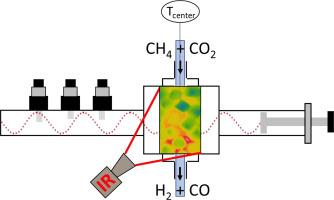Comparing catalyst powders and pellets for microwave assisted biogas reforming
IF 3.9
3区 工程技术
Q3 ENERGY & FUELS
Chemical Engineering and Processing - Process Intensification
Pub Date : 2025-08-10
DOI:10.1016/j.cep.2025.110507
引用次数: 0
Abstract
Reactor electrification is a promising technology to reduce carbon dioxide emissions in the chemical industry. Moreover, it allows for more compact reactor design and leads to process intensification. Microwave technology can be used to effectively heat solid catalysts for endothermic reactions with numerous benefits. However, microwave heating is restricted to certain materials only and in most cases new catalyst development is necessary. Whereas many studies focus on microwave assisted catalysis over powder samples, studies on industrial pellets or extrudates are far less common. This study compares microwave-assisted biogas reforming over 5 wt.% Ni/SiC in powder and pellet form (2 mm × 2 mm), tested at different temperatures (750, 800, and 850 °C) and gas flow rates (100, 200, 300, and 400 mL/min). Both forms of the catalyst show good activity, but limited long-term stability. Radial temperature gradients caused by radiation losses through the quartz reactor wall, were measured directly by using a fiber optic temperature sensor located inside the bed center and an IR camera at the reactor wall.

微波辅助沼气重整催化剂粉末与颗粒的比较
在化学工业中,反应器电气化是一种很有前途的减少二氧化碳排放的技术。此外,它允许更紧凑的反应器设计,并导致过程强化。微波技术可以有效地加热固体催化剂进行吸热反应,具有许多优点。然而,微波加热仅限于某些材料,在大多数情况下,需要开发新的催化剂。尽管许多研究集中在粉末样品的微波辅助催化上,但对工业颗粒或挤出物的研究却很少。本研究比较了在不同温度(750、800和850℃)和气体流速(100、200、300和400 mL/min)下,在5 wt.% Ni/SiC粉末和颗粒形式(2 mm × 2 mm)下的微波辅助沼气重整。两种形式的催化剂都表现出良好的活性,但长期稳定性有限。通过床层中心的光纤温度传感器和反应器壁上的红外摄像机,直接测量了石英反应器壁上辐射损失引起的径向温度梯度。
本文章由计算机程序翻译,如有差异,请以英文原文为准。
求助全文
约1分钟内获得全文
求助全文
来源期刊
CiteScore
7.80
自引率
9.30%
发文量
408
审稿时长
49 days
期刊介绍:
Chemical Engineering and Processing: Process Intensification is intended for practicing researchers in industry and academia, working in the field of Process Engineering and related to the subject of Process Intensification.Articles published in the Journal demonstrate how novel discoveries, developments and theories in the field of Process Engineering and in particular Process Intensification may be used for analysis and design of innovative equipment and processing methods with substantially improved sustainability, efficiency and environmental performance.

 求助内容:
求助内容: 应助结果提醒方式:
应助结果提醒方式:


